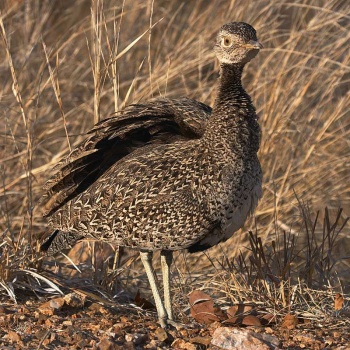Alternative name: Buff-crested Bustard1; Bush Bustard; Red-crested Korhaan
- Lophotis ruficrista
Eupodotis ruficrista
Identification
Length 50 cm (19¾ in), mass 300-910 g; average mass of males (682 g) slightly higher than that of females (667 g).
Adult male: The crown is grey and the crest (which is concealed unless displaying) is rufous. Upper parts are brown; feathers have black centres and white chevron marks. The foreneck is grey. The underparts are black except for white patches on each side of the upper breast. Cream supercilium. The eyes are pale, the bill dark horn and the legs and feet are off-white to grey-green.
Adult female: Similar to the male, but the crown is brown with white flecks, and the neck and upper breast are buff with black flecks, grading to a broad white breast band.
Similar species
The female White-quilled Bustard (Northern Black Korhaan) lacks the white chevrons on the upperparts and has less black on the belly. The Black-bellied Bustard also lacks the white chevrons on the upperparts; the male has a balck stripe down the foreneck and the female has a white belly.
Distribution
Southern Angola and northeastern Namibia, Botswana, southwestern Zambia and Zimbabwe, southern Mozambique, northern South Africa and eSwatini
Taxonomy
This is a monotypic species[2].
Formerly lumped with Buff-crested Bustard and Savile's Bustard.7
Lophotis vs. Eupodotis
The species in genus Lophotis was formerly placed in genus Eupodotis by some authorities, however there now seems to be a consensus for using Lophotis.
Habitat
Semi-arid woodlands, extending into sparsely wooded grassland in the southern Kalahari.
Behaviour
Solitary; inconspicuous unless calling or displaying.
Diet
Forages for invertebrates such as beetles, grasshoppers, ants and termites; also berries, seeds, fruits and gum while walking.
Breeding
Polygynous. The mating display of the male is spectacular; he flies up vertically to a height of 10-30 m, throws his feet up, tumbling over and drops to the ground like a stone, opening his wings at the last minute.
Females are probably not territorial, but nest alone. The nest is a shallow scrape in the ground, often near a shrub or sapling. One to two eggs are laid October to April, peaking earlier in the east. Only the females incubate and care for the young.
Vocalisation
When displaying, the male has an extended vocalisation which starts with a long, accelerating series of clicks: tic, tic, tic, finishing with a long series of piping whistles: pi pi pi pipity pipity. It can also make a squeaky, whistling sound that is very ventriloquial.
References
- Not to be confused with Buff-crested Bustard, Eupodotis gindiana.
- Clements, J. F., T. S. Schulenberg, M. J. Iliff, D. Roberson, T. A. Fredericks, B. L. Sullivan, and C. L. Wood. 2015. The eBird/Clements checklist of birds of the world: v2015, with updates to August 2015. Downloaded from http://www.birds.cornell.edu/clementschecklist/download/
- Dickinson, EC, ed. 2003. The Howard and Moore Complete Checklist of the Birds of the World. 3rd ed., with updates to December 2007 (Corrigenda 7). Princeton: Princeton Univ. Press. ISBN 978-0691117010
- Hockey, PAR, WRJ Dean, and PG Ryan, eds. 2005. Roberts' Birds of Southern Africa. 7th ed. Cape Town: John Voelcker Bird Book Fund. ISBN 978-0620340533
- Sibley, CG and BL Monroe. 1996. Birds of the World, on diskette, Windows version 2.0. Charles G. Sibley, Santa Rosa, CA, USA.
- Sinclair, I and P Ryan. 2003. Birds of Africa South of the Sahara. Princeton: Princeton Univ. Press. ISBN 978-0691118154
- Urban, EK, CH Fry and S Keith. 1986. Birds of Africa Vol II: Game Birds to Pigeons. London: Academic Press. ISBN 0121373029
- Handbook of the Birds of the World Alive (retrieved August 2015)
- BF Member observations
Recommended Citation
- BirdForum Opus contributors. (2025) Red-crested Bustard. In: BirdForum, the forum for wild birds and birding. Retrieved 12 May 2025 from https://www.birdforum.net/opus/Red-crested_Bustard
External Links
GSearch checked for 2020 platform.1





